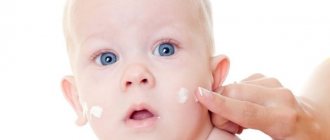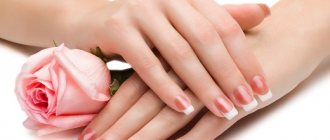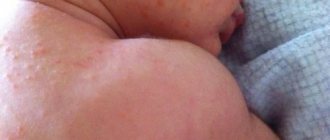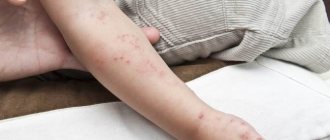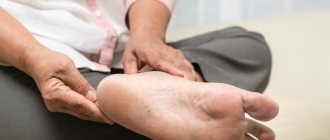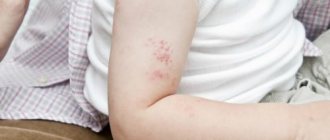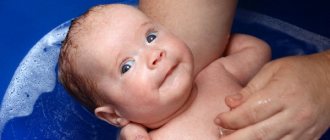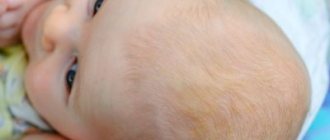Causes of prickly heat in adults
In adults, prickly heat occurs under unfavorable conditions. They can be associated with various diseases, as well as with the individual characteristics of the skin, living and working conditions of the patient. The doctor must identify these circumstances during the diagnostic process.
Pathological causes
Most often, irritation accompanies a number of skin diseases, accompanied by increased sweating and oily skin. The same signs can be observed in a number of endocrine, cardiovascular diseases, and at high temperatures. Often this pathology occurs in overweight patients (they sweat more, there are more folds on their body, which create conditions for prickly heat), as well as in bedridden patients (it can precede bedsores).
Natural causes
Natural causes are those that occur in healthy people. These are situations when a person begins to sweat more, which means the chance of developing heat rash increases. Such reasons include:
- Physical labor, sports;
- Hot weather or poorly ventilated area;
- Uncomfortable clothes, shoes - tight, restrictive, poorly ventilated;
- Neglect of personal hygiene;
- Excessive use of cosmetics in hot weather.
Under such conditions, symptoms of skin irritation can appear even in a healthy person.
Miliaria is considered a childhood disease precisely because children are more often exposed to unfavorable factors - they try to dress them warmly without taking into account their physical activity, protect them from drafts, buy clothes or shoes that do not fit. In adults, the causes of disorders are the same factors.
Preventive measures
People of any gender and at any age are susceptible to diaper rash. To prevent the occurrence of this disease, it is recommended to follow some rules:
- make a choice in favor of shoes made from natural materials;
- adhere to the rules of personal hygiene;
- follow the rules for visiting swimming pools and saunas;
- do not use other people's shoes and clothes;
- do not use other people’s pedicure tools;
- moisturize the skin of the feet.
By following these steps, the risk of diaper rash will be minimized.
What does prickly heat look like in adults?
Depending on the characteristics of the manifestation, several types of the disease are distinguished. Their common symptoms will be a characteristic localization, an unpleasant odor of sweat, pain, and skin damage in the affected area.
Crystalline prickly heat - the safest type
It is called crystalline for its characteristic appearance - rashes on the skin resemble small crystals of salt. The elements of the rash themselves are small, prone to merging, and burst easily. The skin is slightly reddened and a little loose in appearance. This disease looks unpleasant, causes mild discomfort, but extremely rarely causes complications.
Miliaria rubra (inflammatory)
It occurs when the deep layers of the skin are affected. The bubbles are quite large, their contents are cloudy, and after rupture, a small depression remains on the skin (erosion). The skin is red, inflamed, and painful to touch. This condition can occur in a woman during pregnancy or after childbirth, when immunity is reduced.
Papular miliaria
Continuation of the red variety. The reason is the addition of a bacterial infection. Signs of inflammation become clearly visible, the elements of the rash are large, with cloudy or reddish contents. The skin is sharply painful when touched, even at rest. It often develops into more serious forms - pustular diseases, boils, pyoderma, erysipelas.
Apocrine miliaria
Apocrine sweat glands produce thicker sweat than regular sweat glands. They are located in the groin, around the anus, under the armpits.
If their work is disrupted, apocrine prickly heat occurs, which is characterized by persistent manifestations, an unpleasant odor, and noticeable discomfort for the patient.
Typical locations of the disease
Miliaria is located in areas where high temperature and high humidity conditions are easily created and maintained. These are natural folds of human skin:
- Groin area, genitals, anus, inner thighs;
- Folds under the knees during sedentary work;
- Feet in closed shoes;
- Armpits;
- The area under the breasts in women;
- The back of the neck, forehead (if these areas are tightly covered with hair);
- Flexor surface of the elbow;
- Folds of skin on the neck, abdomen, sides, back in obese people.
Sometimes the disease can occur on open areas of the body - on the face or chest, which indicates serious general problems.
How to understand that the disease is progressing or complicated by infection?
As a rule, prickly heat is a harmless disease. But damaged skin becomes an entry point for infection, and this is what makes the disease dangerous. Alarming symptoms may include:
- Increased pain in the affected area;
- Increase in local temperature;
- Increased redness, the appearance of bubbles with cloudy or bloody contents;
- Deterioration in general health.
In such situations, you should immediately consult a doctor.
Hives
The second type of skin irritation is cholinergic urticaria: an autoimmune allergic reaction to acetylcholine, a neurotransmitter that is released during sweating. This pathology is secondary in nature and develops against the background of other diseases of the body.
Factors provoking the appearance of pathology:
- Excessive physical activity.
- Drinking alcohol, hot drinks, spicy foods, large amounts of liquid.
- Hot climate, prolonged stay in a hot, unventilated room.
- Disturbance of the gastrointestinal tract and endocrine glands.
It may also be a specific reaction of the body to changes in environmental temperature in the form of increased release of histamine.
Symptoms of urticaria
After profuse sweating, a pinpoint rash appears, reminiscent of a nettle burn. The blisters are watery, up to 3 mm, surrounded by a red border.
The skin in the area of the rash is hot and itchy. The rash occurs in areas of the greatest sweating.
Often accompanied by a deterioration in general health: nausea, vomiting, and loose stools.
In severe cases of the disease, frequent relapses are observed.
Treatment of prickly heat in adults
Treatment of the disease includes several stages. Mild forms only require the creation of suitable conditions and go away on their own, but sometimes more serious treatment may be needed. If symptoms occur frequently and for no apparent reason, a thorough examination is required.
Elimination of provoking factors
Provoking factors are heat, humidity, friction. To reduce their impact, you need to take care of selecting clothes, shoes, and underwear that are appropriate for the weather, are well ventilated, and provide comfortable wearing. At home, it is useful to spend some time without clothes or shoes on the affected areas.
Elimination of excessive sweating
Several different methods are used for this. The simplest of them is the use of antiperspirants and a daily (or several times a day) shower. This method is suitable for the treatment and prevention of prickly heat. In more serious situations, it is necessary to use ointments and creams against excessive sweating; in the most severe cases, surgery to prevent hyperhidrosis.
Physiotherapy
It is prescribed if the patient suffers from severe hyperhidrosis as an independent disease, or its symptomatic form. For this purpose, acupuncture is used - acupuncture at strictly defined points, which cause a decrease in the sweating reflex.
Phytotherapy
To relieve the symptoms of prickly heat at home , plants that improve skin nutrition, have an anti-inflammatory effect, and reduce sweating are well suited. In this regard, chamomile and calendula are absolutely irreplaceable - they simultaneously have anti-inflammatory, antiseptic, and regulatory functions. They are used in the form of decoctions, infusions or tinctures - they treat the affected areas. Celandine and rosehip are also used - they effectively eliminate excess sweating.
Antiseptics
Antiseptics for external use are used to prevent infection and complications. It is advisable to use products with a drying effect - hydrogen peroxide, alcohol solutions, boric acid. Chlorhexidine and miramistin have less effect. You can use a solution of potassium permanganate (a faint pink color), but this must be done with caution to avoid burns. Traditional iodine and brilliant green are not effective enough.
Oral antibiotics
They are necessary if prickly heat is complicated by a bacterial infection or the affected areas have been exposed to contaminants. As a rule, Amoxiclav or Lincomycin are prescribed.
Antihistamines
They are used for severe inflammation in the affected area, severe irritation of surrounding tissues, and the need to quickly cure the disease. Most often, Suprastin, Zodak or other fairly old, but effective and inexpensive drugs are prescribed. Side effects include drowsiness and decreased mental performance, so they are used only when necessary, if the means for external use are not effective enough.
Preventing diaper rash between the toes
The skin between the toes is very sensitive, so regular friction and moisture can cause irritation. To prevent diaper rash, you must follow the following preventive measures:
- Hygiene. You should wash your feet with antibacterial soap twice a day.
- Treatment. In case of excessive sweating, regularly treat the interdigital area with talcum powder, baby powder or Teymurov's paste.
- Disinfection. To disinfect cracks and abrasions on the feet, use antiseptic solutions - Chlorhexidine, Miramistin, Furacilin solution.
- Timely treatment of diseases. It is necessary to promptly stop relapses of dermatological pathologies - mycoses, candidiasis, impetigo, etc.
If prevention is not followed, all symptoms of the disease may return. The effectiveness of treatment largely depends on whether you have eliminated the provoking factors. To reduce the risk of exacerbation of diaper rash, it is necessary to follow sanitary and hygienic rules, monitor your immunity, and wear only high-quality shoes.
Cream and ointment for prickly heat
To speed up the restoration of the skin, various medicinal ointments are used - Bepenten (accelerates healing), Celestoderm (anti-inflammatory), Zinc ointment (disinfects the skin), Levomikol (prevents bacterial complications). For heat rash on the legs, it is advisable to use antifungal ointments. Products with similar active ingredients may be sold under different trade names. All of them are sold in pharmacies without a prescription, but it is advisable to select an ointment on the advice of a doctor.
Folk remedies for prickly heat
Traditional medicine suggests strict adherence to personal hygiene as the main method of treatment. Frequent washing followed by dry drying should have a beneficial effect - eliminating excess sweat and sebum. To enhance the effect, it is suggested to wash the skin with laundry soap. After washing, be sure to wipe the skin dry and let it sit in the air for a while (even if we are talking about the intimate area).
Infusions and decoctions of herbs, which are listed in the section on herbal medicine, are widely used. They treat damaged areas. You can use alcohol tinctures and essential oils. Do not apply compresses - this will only worsen the condition of the skin.
Little women's secrets
Special attention should be paid to prickly heat in the groin in women. This problem occurs quite often during pregnancy and after childbirth, and can cause thrush or other infections. Men also experience prickly heat on the genitals, but it is usually easier to tolerate.
To cope with it, it is recommended to toilet the genitals daily (and in hot weather, several times a day), regularly shave, treat with antiseptic solutions, and change panty liners several times a day. If irritation occurs every time you have your period, you may want to consider choosing a different brand of pads. Intimate life is not contraindicated, since the disease is not contagious, but intimacy at this time will be painful, so it is better to postpone it until recovery.
Reviews
Dear readers, your opinion is very important to us - therefore, we will be glad to receive your feedback on the quick treatment of prickly heat in adults in the comments, this will also be useful to other users of the site.
Elena
With the onset of menopause, sweating increased. Since I have weight problems, sweat began to accumulate in my folds and cause irritation, which led to breakouts. To eliminate discomfort and inflammation of the skin, I began to take frequent showers and used talc. She took baths with chamomile and gave up spices and spicy foods. Miliaria in the form of rashes and discomfort began to recede.
Nellie
My mother had prickly heat. The inflamed areas were very itchy, and crusts appeared on the affected areas. We visited a dermatologist, he prescribed Pantoderm anti-prickly heat cream and recommended compresses with oak bark decoction.
